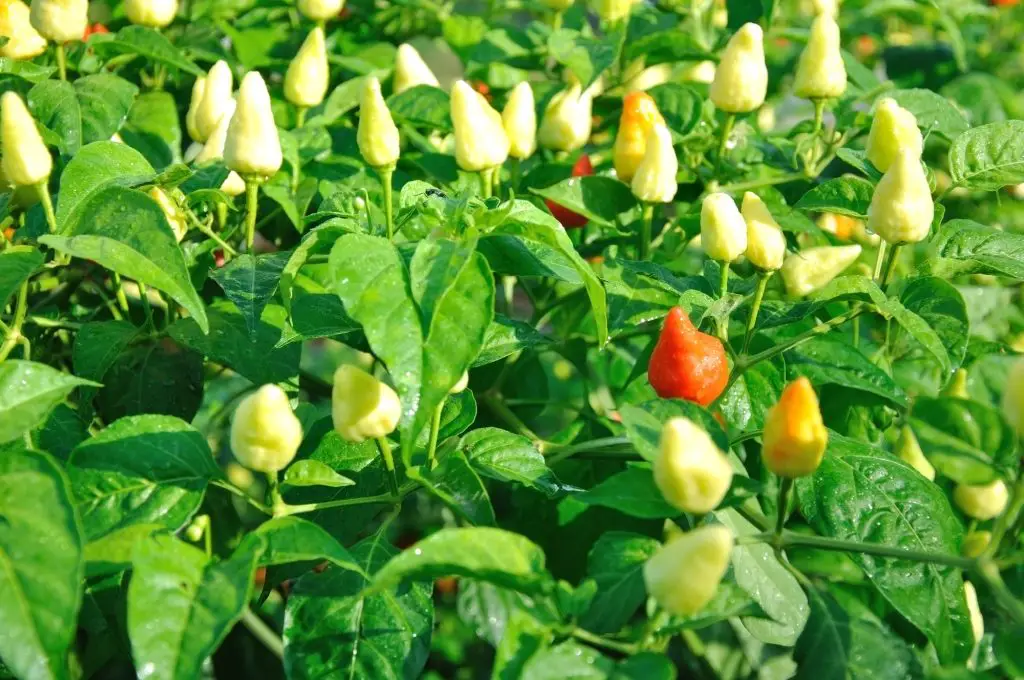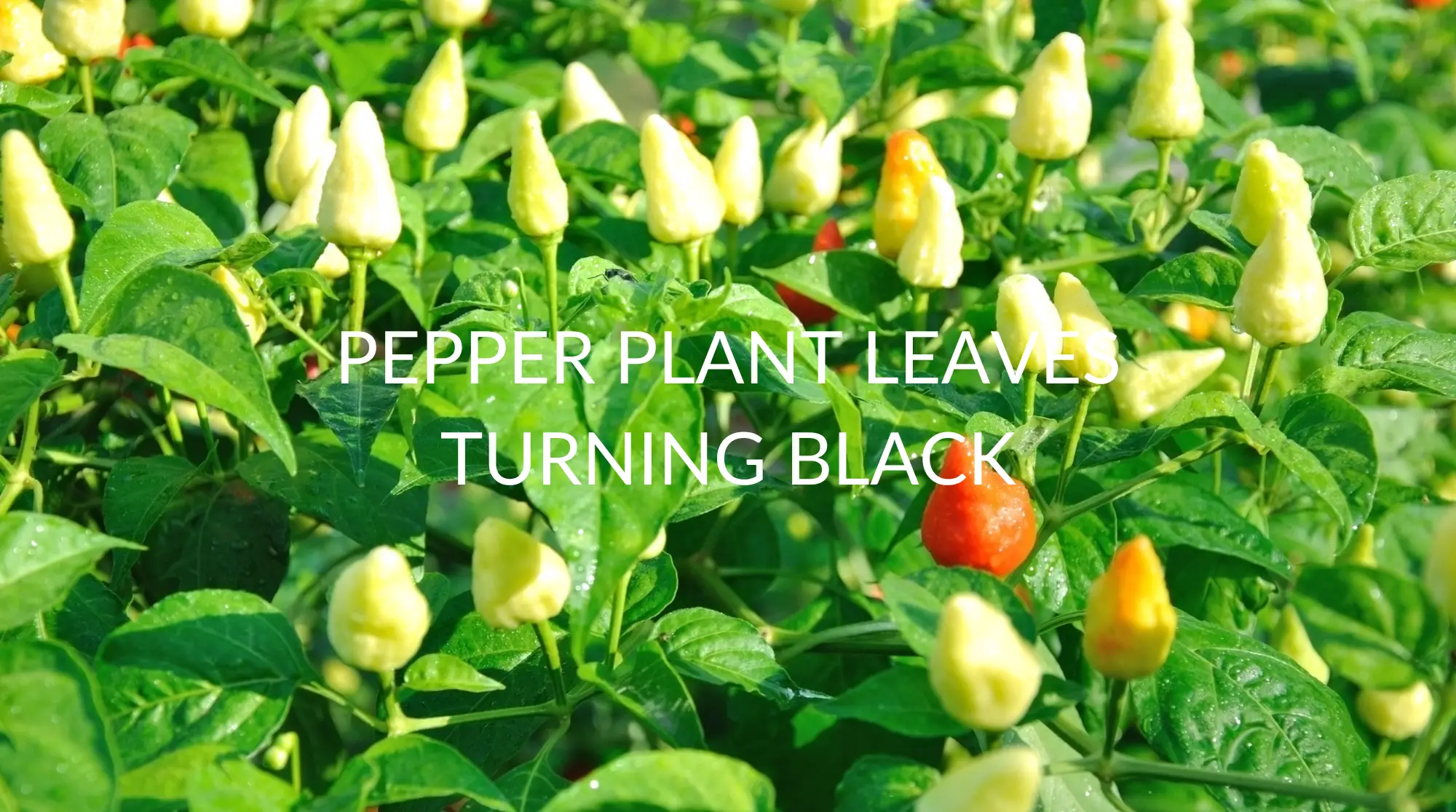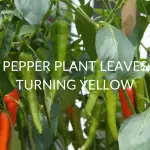Pepper plants can come in over fifteen varieties. Each one offers a different delicious fruit, blending colors of orange, red, yellow, and even dark green peppers with the verdant color of the plant’s leaves and stems! However, one color you might worry about seeing in your pepper plant is the color black.
Pepper plant leaves sometimes turn a dark, troubling hue. In this article, we’ll give you the fruits of our research to cover not only why the leaves of your peppers are turning black but how to treat the areas, how to prevent the dark color from coming back, and even some frequently asked questions on the subject!
Why Are My Pepper Plant Leaves Turning Black?
If you’ve noticed black leaves or even just black spots on your pepper plants, there are a few reasons behind it. Below is a list of those possible causes:
- Overwatering
- Bacterial Spots
- Cercospora
- Mildew
- Incorrect Fertilizer
- Aphids
Let’s take a more detailed look at each of these possible reasons for your pepper plant leaves turning black.
1. Overwatering
All plants need a certain amount of water to survive. However, the pepper plant only wants to drink so much before it starts reacting badly to too much hydration.
The darkness showing up in the leaf of your pepper plant is actually a symptom of rot, which happens when the roots are not given enough oxygen to survive and subsequently start dying.
2. Bacterial Spots
Bacteria growing on your pepper plant and causing leaves to turn black may not actually be your fault. Instead of developing bacteria which results in blackness on the leaves because of overwatering, sometimes these spots can appear because of unfavorable weather.
When the weather is too cold or, again, too moist, a pepper plant can grow tiny single-celled organisms that feed negatively on the plant. They show up as purple speckles with dark black middle sections and can affect not only the leaves but your pepper fruits, too.
If left unchecked, peppers suffering from bacterial spots will start to feel more like foam corks and drop away.
3. Cercospora
If you’re noticing spots on your pepper plant’s leaves and peppers, they may not be the result of bacteria but rather a fungus called cercospora beticola.
Cercospora is a result of overwatering, usually. It acts as a disease, carried by the wind and looking for a moist area to infect. It is a very hardy type of fungus and can even survive harsh winters when the plant is inactive. Like bacterial spots, cercospora causes discoloration in leaves and fruit and causes the plant to drop both.
4. Mildew
Some mildew types that plague pepper plants show up as white fuzz, but sometimes they cause a black furriness in the leaves instead. This is sometimes called “sooty mold.”
Black mildew is actually just a symptom of insect infestation, taking the form of a fungus that grows on the secretions that bugs leave behind. The fungus prevents the leaves from being able to perform photosynthesis, gaining energy from the sun, and damages the health of the plant.
5. Incorrect Fertilizer
If you have a fertilizer that is too heavy in the salt mineral, it will show up by visibly mottling your pepper plant’s leaves with a purplish-black color. Sometimes gardeners will use this extreme mixture of soil, thinking of it as a superfood for their plants.
Instead, pepper plants cannot process these minerals quickly enough for the growth of the leaves, making them soft and weak when fungal infections come along to cause trouble. Therefore, the leaves turn brown or black.
6. Aphids
Aphids are tiny insects of an orange variety with black spikes. They love to feed on healthy plants in big crowds. Unfortunately, while they’re eating, they’re also producing a secretion called “honeydew.”
This secretion is named for the high amounts of glucose within. Honeydew is a favorite food for sooty mildew, meaning aphids are directly responsible for this form of blackness on leaves.

How Do You Treat Black Spots On Pepper Leaves?
Now that we’ve covered some of the most probable causes for black leaves, let’s cover how to get rid of the problem! Below is a list of steps for treating the black spots you see on your pepper leaves:
- Locate the Infected Area
- Clean Shears and Hands
- Remove Infected Area
- Burn or Trash Infected Leaves
- Check For Returning Infection
Getting rid of the infected leaves is the only guaranteed way to eliminate the black spots on pepper leaves. Let’s take a closer look at how to accomplish each of these steps.
1. Locate the Infected Area
If you want your pepper plant to have a chance at surviving whatever is causing the black leaves, it is important to only remove the infected area. Be sure that the leaves you’re planning on getting rid of are black as a result of rot, mildew, bacteria, or fungal infection.
If you’re noticing discoloration like brown or wilted leaves, there is a chance that these are only looking rough because of a lack of water or overexposure to direct, hot temperatures. Additionally, if you accidentally remove healthy leaves, that is one less part of your plant that can give your peppers what they need to maintain health from photosynthesizing.
2. Clean Shears and Hands
Before you can begin pruning away the infected area, you need to make absolutely sure that anything touching the infected plants is clean. This is because both your hands and any gardening tools can carry harmful microbes and viruses.
If you’re not careful to sanitize whatever you use to rid yourself of black leaves, you may wind up making the problem worse. Try using an isopropyl alcohol solution to soak your shears before touching them to your plant.
3. Remove the Infected Area
Now that you’ve narrowed down exactly which parts of the pepper plant you’re getting rid of and cleaned your pruning tools, it is time to get to work! Clip the leaves at the very base of the infection of bacteria, close to where you no longer see black spots.
If this means removing an entire branch of leaves, don’t be discouraged. Getting rid of bacteria in a drastic way will be better for your pepper plant in the long run.
One sad thing to note is that if your pepper plant has black leaves as a result of overwatering, causing rot, it may be too late to remove a single portion. In the case of rot, it may be time to get rid of the whole pepper plant and start again.
4. Burn or Trash Infected Leaves
Especially in the case of fungal growth, bacterial infection, and mildew, it isn’t enough to throw the leaves on the ground or in a compost heap. In fact, doing so can wreak havoc on your garden as the dead leaves spread their black problem to other plants.
Instead, there are two safe ways to dispose of the infected areas which you’ve cleanly and carefully removed. One option is to simply make sure all of the damaged clippings are safely placed in a garbage bag, thrown out, and removed from the garden area.
Another option is to gather all of the infected plants and burn them up in a controlled environment, like a fireproof pot or even a backyard campfire. This will ensure that the infection doesn’t spread to other plants that are susceptible to the same problems, like tomato plants or healthy pepper plants.
5. Check For Returning Infection
Even after completing these steps, there’s always a chance that the gardener either missed a spot of the black area, or the issue that originally caused the blackness to appear is still present in the plant.
For this reason, be sure to take a week or so to inspect your pepper plant thoroughly each time you go out to tend to it. If the infection returns in the form of more black leaves, then preventative measures will need to be taken.
How To Prevent Pepper Plant Leaves From Turning Black
It is helpful to understand why pepper plant leaves turn black and how to get rid of them, but if the infection returns, you may be wondering what you can do to keep it from happening altogether. Below is a list of ways to prevent pepper plant leaves from turning black:
- Water Correctly
- Rotate Your Pepper Plants
- Keep All Old Veggie Debris Out of Area
- Spray for Insects
- Apply Proper Fertilizer
Let’s look at these preventative methods more closely.
1. Water Correctly
Overwatering is what begins the problem of root rot, which is a very deadly cause of black leaves. To keep your pepper plant from having the opportunity to rot, make sure you’re watering it the proper amount.
Pepper plants only need to be watered about once per week, especially during mild seasons when you will be harvesting their fruit. In hotter climates, or during summer months, it is permissible to water the plant once a day, but check the soil to be sure. If it is moist to the touch, you can likely skip watering and check again the next bright summer morning.
2. Rotate Your Pepper Plants
One way of making sure that your pepper plant is safe from bacterial infection or fungus growth, or even insect infestation is to keep it away from other pepper plants.
This works the same way as it does with human beings who are sick: the infected people typically stay quarantined away from healthy humans, who are vulnerable to the same disease.
Simply consider planting pepper plants in a different spot from the other pepper plants so that if one gets infected, it will not be able to spread the problem as easily to its fellow peppers.
Additionally, planting the same plants in the same spot every year causes them to gradually soak up all the nutrients specific to their plant type. That soil will remain depleted after three years; it can be rejuvenating for the health of your pepper plant, as well as preventative against black leaves, to move it to a fresh part of the garden or field.
3. Keep All Old Veggie Debris Out of Area
Rotting vegetable debris can carry bacteria from one affected plant to another. If you even leave the leaves of a dead plant on the soil of a pepper plant, there is a chance that the issue could spread black leaf symptoms to the peppers.
Make sure that you remove any dropped vegetables from the space your pepper plant occupies so that there aren’t any opportunities for contagions to spread.
4. Spray For Insects
Using an insecticidal soap can keep aphids away from your pepper plant. No aphids mean no honeydew secretion. Without this glucose-ridden substance coating your pepper plant, soot mildew will have nothing to feed on. This should keep your pepper plant safe from this particular cause of black leaves!
One insecticidal soap can actually be made at home using one cup of oil with a pure dishwashing soap (as long as it contains no bleach or degreaser.) Then add two tablespoons per cup of warm water and gently mist the plant.
5. Apply Proper Fertilizer
As previously stated, some leaves are not given a fighting chance against infection because they developed too quickly without sufficient nutrients; this is a result of the wrong kind of fertilizer.
Instead of fertilizer with too high a level of salt content, try a balanced fertilizer with no phosphorus. Additionally, fertilizer should only be applied two weeks after a new pepper plant’s seeds have produced a sprout.
Frequently Asked Questions
Below are some frequently asked questions associated with pepper plant leaves turning back!
Why Do My Pepper Plants Have Black On Them?
According to Gardening Know How.com, your pepper plants may have a bacterial infection such as cercospora or be covered in sooty mildew as a result of insect infestations. This causes black speckles or mottled, fuzzy black films over pepper plant leaves.
What Does An Overwatered Pepper Look Like?
According to the founder of PepperScale.com, overwatered pepper fruits may not have outward signs of being drowned. However, the fruit will be less spicy. The plant itself will usually have wilted or curled leaves and black spots.
Why Do My Pepper Plant Leaves Look Burnt?
Burnt-looking pepper leaves, which are browning leaves blending into black coloration, are the result of either too much water or too much exposure to direct sunlight. Move your pepper plant to a shadier spot and only water it once a week.
Summary
In summary, a pepper plant’s leaves may turn black because of bacterial infection, fungal spread, or mildew growth. This can be the result of overwatering, insect infestation, or simply contact with a type of disease.
Your pepper plant will have the best chance of avoiding blackened leaves if it receives the proper fertilizer, water, and is kept away from diseased plants and debris. If you do see blackened leaves, determine the cause. You may be able to save the plant by pruning away and burning the blackened leaves.







